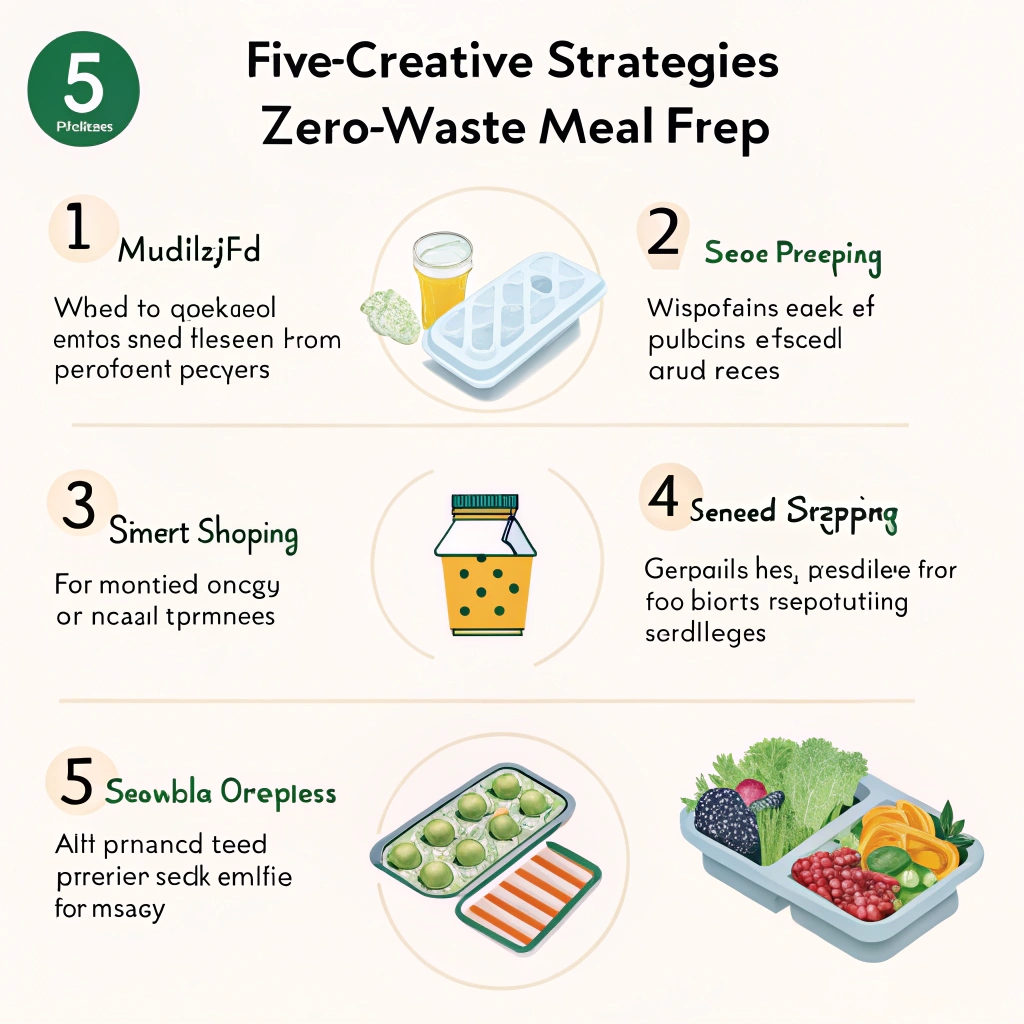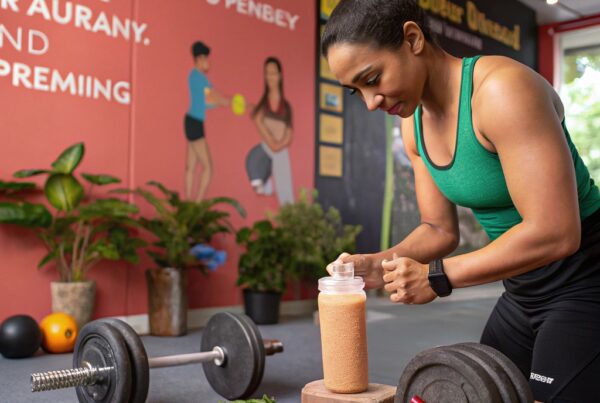Are you tired of meal prep being a chore, not a game-changer?
Let’s face it – cooking healthy meals can be overwhelming. You’re expected to be an expert chef, plan out every day for weeks ahead and still somehow keep your family fed.
But what if I told you there are creative ways to zero waste meal prep that don’t require sacrificing flavor or creativity?
With these 5 innovative strategies, you’ll not only fuel your active lifestyle but also stay true to yourself while reducing food waste in the process. Get ready for a game-changing approach!
From repurposing leftovers like a pro, to finding inspiration from unexpected places and much more – we’re diving into practical tips that make zero-waste meal prep both enjoyable and sustainable.
Swap Your Starches for Plants
Looking at getting your meals planned out in a way that aligns with your active lifestyle without sacrificing what matters, let’s dive into swapping starches for plants.
Relying on whole foods like sweet potatoes and chickpeas can be key to fueling up without feeling weighed down. These plant-based staples pack a punch of nutrients while providing sustained energy levels throughout the day. Plus, they come with added health benefits that supercharge your body’s ability to perform daily tasks.
The beauty about these plant-based options is their versatility – you can roast them in the oven for a hearty dinner or blend them into smoothie bowls that are both nutritious and delicious. And when it comes to meal prep, using starchy veggies like parsnips and carrots add natural sweetness that makes healthy eating feel less monotonous.
Instead of turning to white starches as your go-to food sources, consider replacing them with plant-based staples like lentils or quinoa for a nutritional boost and some well-deserved variety. These nutritious foods make mealtime fun again!
Reuse and Repurpose Ingredients with Creative Combinations
The Power of Creativity in Zero Waste Meal Prep: Minimize Food Waste, Maximize Flavor
When it comes to zero waste meal prep that fuels your active lifestyle, creativity plays a vital role. Did you know that one-third of food produced globally is lost or wasted? By thinking outside the box and experimenting with different combinations, you can minimize food waste while nourishing your body.
Consider this: when cooking in bulk for just a single meal, we end up with excess ingredients that often go to waste. A recent study found that 40% of household food goes uneaten each year – an alarming number considering the environmental impact it has. By repurposing leftovers and creatively using vegetables before they spoil, you can significantly reduce your carbon footprint.
Take for example combining leftover chicken from last night’s dinner with fresh greens to make a hearty chicken salad for lunch tomorrow. This not only reduces food waste but also provides variety in meals without increasing water usage or energy consumption.
Another genius idea is turning vegetable scraps into delicious soups and broths that can be repurposed into pasta sauces, curries, or stews later on. Simply chop the scraps up with some water, let it simmer for 30 minutes to an hour, then strain the liquid and add it as a flavorful base.
Spices and herbs also play a crucial role in creative meal prep. Instead of using fresh cilantro solely for guacamole one day, why not dry some cilantro by air-drying or dehydrating? You can use this dried herb to infuse flavor into soups, curries, and even baked potatoes.
When it comes to preparing meals that will be used later in the week, roasting large quantities of vegetables is a fantastic strategy. Sweet potatoes roasted for future fries are a great example – they’re perfect when reheated with some oil and herbs! Simply slice them up into sticks or cubes, toss with olive oil and seasonings, and roast at 400°F (200°C) for about an hour. To dry cilantro effectively without losing its flavor, follow these simple steps: gently pat the herb leaves dry on a paper towel to remove excess moisture. Lay it out flat in a single layer on air-drying racks or sheets lined with parchment paper and allow it to sit at room temperature (65-75°F/18-24°C) for 2 days, flipping mid-day.
To dry cilantro effectively without losing its flavor, follow these simple steps: gently pat the herb leaves dry on a paper towel to remove excess moisture. Lay it out flat in a single layer on air-drying racks or sheets lined with parchment paper and allow it to sit at room temperature (65-75°F/18-24°C) for 2 days, flipping mid-day.
To cut down on what is wasted by cooking whole meals, aim to use three times more vegetables than you actually need. For example if a recipe calls for two carrots, add an additional one or two extra because they’ll be useful in future recipes as well!
When incorporating herbs and spices creatively into your meal prep, consider the following: Thai basil can enhance the flavor of noodle dishes by mixing it with sesame oil; cilantro’s fresh taste is fantastic when combined with lime juice – try adding a squeeze to Mexican or Asian-inspired meals for a zesty twist.
By embracing these simple strategies, you’ll not only reduce food waste but also elevate your meal prep game while saving energy. Start today and get inspired by creative zero-waste recipes!
The Science Behind Food’s Carbon Footprint Reduction Strategies
Let’s face it, reducing food waste is easy to talk about, but implementing sustainable meal prep strategies can be daunting. Want to reduce your carbon footprint without sacrificing flavor or convenience? Start with simple meal prep strategies that can transform your kitchen.
Carbon footprint reduction can be achieved through several simple strategies in meal prep. For instance, choosing seasonal produce makes a big impact on the environment. When your grocery list is full of exotic fruits and vegetables out of season, it’s like buying for the wrong week – research shows that the global greenhouse gas emissions from fruit and
your week-old rice and soup leftovers into new meals. This is where repurposing gets really
vegetable production have increased by 20% in recent years, largely due to transportation costs. This means not only do you risk wasting nutrients, but also contributing to unnecessary energy expenditure.
Buying in bulk with minimal packaging is another strategy worth exploring. Opt for products like nuts or grains sold in cardboard boxes instead of single-use plastic bags or packets. Not only does this reduce waste that can end up in oceans and landfills, but it’s also a great opportunity to explore new recipes and flavor combinations.
Cooking at home instead of relying on restaurants or takeout when you’re short on time may seem counterintuitive as an environmental strategy – after all, who doesn’t love the convenience? However, there are still some environmental impacts to consider. For instance, reheating food requires energy that’s generated by burning fossil fuels and releases greenhouse gases into the atmosphere.
One common pitfall is buying more food than can be consumed in one day. This not only wastes nutrients but also perpetuates consumerist culture – you’re essentially saying “I’ll just buy enough to feed myself for a week, even if I’m sure it will go bad by dinner.” The statistics are staggering: the average American household throws away $1,400 worth of groceries each year due to waste. This translates into a significant amount of energy consumption and unnecessary packaging.
Using up everything that comes into your kitchen is not only better for the planet – but also helps you save money on food waste disposal costs and reduces your grocery bill in the long run. So next time you’re planning meals, ask yourself: what can I use all these ingredients for? Get creative with leftovers or try new recipes to minimize food scraps.
Here are some key characteristics of locally sourced items:
- Locally grown produce is often picked at peak freshness due to reduced transportation times.
- Seasonal fruits tend to have higher nutrient content and longer shelf life.
Using Leftovers to Spark New Meals
Leftover food is discarded by 40% of households in the US every year, resulting in millions of dollars wasted and unnecessary environmental harm. But with a little creativity, you can change this statistic by repurposing leftovers into new meals that are not only nutritious but also budget-friendly.
When cooking for one or two people at home, it’s easy to throw away leftover food as soon as dinner is over. However, this practice is costly and wasteful. To avoid falling into this trap, plan your meals around the ingredients you already have on hand. Consider the following strategies:
Use last night’s roasted vegetables as the base for a fresh salad today.
For instance: Turn yesterday’s roast chicken into tomorrow’s breakfast by adding eggs or avocado to create a protein-packed meal that will keep you full until lunchtime.
Try turning creative – like this: Shred the cooked rice, mix it with some pre-cooked vegetables and chicken broth for an easy-to-make stir-fry base.
Repurposing food can save you money by reducing food waste and allowing you to stretch your grocery budget further.
When done correctly, using leftovers as a resource instead of throwing them away reduces what ends up in landfills. Not only that but it also cuts down on unnecessary packaging from fresh groceries which is great for the environment.
For example, if you were planning a week-long meal plan and accidentally ordered too much food or had leftover ingredients when cooking last night’s dinner, do not be discouraged by this mistake – instead look at it as an opportunity to think ahead. Try making meals in bulk that will use up these extra portions.
Store leftovers properly: before reheating them make sure the contents are heated to 165°F and only consume them within a day or two after storing.
For instance, let’s say you cooked some roast chicken on Sunday evening for dinner with mashed potatoes. Simply store leftover mashed potatoes in an air-tight container, set aside space for it when preparing lunchtime soups or salads tomorrow.
Salads can be composed of different types of greens such as mixed leaf lettuce and/or spinach. The key is to get your hands dirty, incorporate various vegetables that complement the left over protein – think fresh veggies from last night’s roast chicken.
Using leftovers also sparks creative ideas on how you can mix things together like rice with a sauce for soup or roasted turkey in salad bowls.
Transforming Scraps into High-Value Ingredients
Get creative and breathe new life into your meal prep routine by repurposing food scraps into high-value ingredients. This approach not only reduces waste but fuels your active lifestyle.
Imagine sipping on a refreshing drink infused with citrus peels for an extra dose of flavonoids, the outer layer contains fiber and antioxidants that support immune function. To make it, use 1/2 teaspoon of grated peel in every glass of smoothies or add directly to other recipes for a nutritional boost. Citrus peels can also be used to flavor soups like chicken noodle soup with vitamin C.
Carrot tops, finely chopped with garlic and olive oil, create a nutrient-dense sauce rich in vitamins A and K that support eye health and bone density. To make pesto, combine 1 cup of chopped carrot tops for every recipe. For an added boost to soups or smoothies, use 1/2 teaspoon of grated citrus peel.
Onion peels can be sautéed in olive oil as a flavorful addition to any meal, rich in antioxidants and flavonoids that support heart health. Similarly, celery roots add a depth of flavor with their unique nutrient profile. Use the stalks to make stocks or soups for an extra dose of vitamin K.
For example, blend 1/4 cup of chopped onion tops with water in a blender to create a plant-based milk alternative rich in prebiotic fibers and antioxidants. You can also strain it through cheesecloth or fine-mesh sieve for a smoother consistency. By incorporating these simple ideas into your meal prep routine, you’ll be fueling an active lifestyle while reducing food waste.
By embracing the art of creative repurposing, you’ll unlock new flavors, textures, and potential benefits that make every bite count in your journey to wellness.
Inverting Your Pantry Staples for a Zero Waste Diet
Reclaim Your Pantry: A Zero-Waste Diet Strategy
When a closer look at your pantry staples reveals near-expiration dates and untouched items, it’s time to rethink your approach. Take stock of canned goods, grains, spices, and other non-perishable items that are on their way out.
Consider the power of creative repurposing:
Transform canned beans into creamy hummus by blending with lemon juice, garlic, and olive oil. Use old bread as croutons for salads or breadcrumbs to make crispy pizza toppings. You can also bake it into a savory bread pudding or use it to soak up excess moisture from leftover soups.
Use old bread as croutons for salads or breadcrumbs to make crispy pizza toppings. You can also bake it into a savory bread pudding or use it to soak up excess moisture from leftover soups.
Get inspired by these examples:
- Turn last night’s roast chicken into tomorrow’s lunch with some creative soup ingredients (e.g., carrots, celery, and onions).
- Use zucchini as a pizza crust base instead of traditional dough.
- Make the most of your weekly meat sales: use ground beef to make tacos one day and burgers another.
Infographic idea: Share a visual representation of pantry staples that can be repurposed into new meals. This will help readers see just how versatile their ingredients really are!
The benefits extend far beyond the kitchen:
Reducing waste helps save you money, reduces your carbon footprint, and minimizes food spoilage.
So what’s holding you back? Don’t let fear of the unknown stop you from experimenting with creative pantry reuse.
Here’s a challenge: Try substituting leftover vegetables with other ingredients to create new recipes. Who knows – it could become a favorite!
Don’t be afraid to try new things, and remember that every small change can add up to make a big impact in your daily routine.
Take the leap of faith and see where creative pantry reuse takes you!
How Microgreens and Greens Can Save Your Meal Prep Game
Microgreens: The Secret to Nutritious Meal Prep
Adding microgreens to your meal prep routine is a game-changer. These nutrient-dense young green veggies pack a punch of vitamins and minerals that can boost your immune system and reduce food waste.
Unlike mature greens, which are often overhyped for their health benefits, microgreens offer an intense dose of nutrition in every bite. Whether you’re looking to add freshness or variety to your meals without breaking the bank, microgreens have got you covered.
Can you really expect your meals to be as nutritious and delicious without adding a handful of these tiny greens? We thought so – until we discovered their secret ingredient: convenience!
Microgreens are superfood-rich, containing up to 40 times more nutrients than their mature counterparts. They’re also incredibly versatile, making them the perfect addition to soups like minestrone or creamy sauces like hollandaise.
By incorporating microgreens into your meals, you’ll not only be reducing food waste but also saving time and money in the long run. Plus, they add a burst of flavor that will take your meal prep from basic to brilliant!
Want to know the best part? Microgreens are ridiculously easy to incorporate into your daily routine. Try adding 1-2 tablespoons of pea shoots to your morning omelette or using 1 cup of chopped microgreens like sunflower sprouts in soups.
Not only will you be reducing food waste, but also investing in a healthier version of yourself – one that’s worth every penny! By embracing the world of microgreens, you’ll never go back to plain old kale again. So what are you waiting for? Dive into the world of microgreens and experience the magic for yourself!
Repurposing Fruit Pulp, Peel, and Core
Repurposing often-discarded fruit pulp, peel, and core is a key strategy for taking your zero-waste meal prep to the next level. By using every part of your fruits and veggies, you’ll not only reduce kitchen waste but also unlock new flavors and possibilities for creative meal prep.
Pineapple tops make an excellent addition to soups or stews, adding a burst of tropical flavor that’s hard to find in most recipes. Try mixing them with diced chicken and soy sauce for an Asian-inspired stir-fry, or blend them into smoothies for added nutrition. If you’re feeling adventurous, use pineapple tops as a crunchy topping for tacos or salads.
Apple cores can be transformed into delicious homemade condiments like applesauce or chutney. Simply cook down the apple scraps with some sugar and lemon juice to create a sweet and tangy spread perfect for topping toast or yogurt. You can also make apple butter by blending cooked-down apple cores with cinnamon and a hint of nutmeg – it’s a game-changer for breakfast or snacking.
Banana peels are packed with nutrients, making them an excellent addition to face masks or beauty treatments. Mash up the peel with some honey and yogurt to create a soothing mask that’ll leave your skin feeling smooth and refreshed. Alternatively, use banana peels as a natural fertilizer for your indoor plants – they’re rich in potassium and other essential minerals.
Citrus fruit peels are another treasure trove of nutrients waiting to be unlocked. Orange and grapefruit peels add a tangy, vitamin-rich flavor to roasted vegetables or stews. Try zesting the peel into your favorite salad dressing for an extra kick, or blend it into smoothies for added nutrition. For a natural cleaning agent, mix citrus peels with water and vinegar in a spray bottle – the acid helps cut through grease and grime like magic.
Don’t throw away your fruit like you would trash a perfectly good party invitation. By repurposing often-discarded parts of fruits, you’re not only reducing waste but also unlocking new flavors and possibilities for creative meal prep that’s both sustainable and delicious. Get creative with those scraps, and watch your zero-waste game soar!
The Surprising Health Benefits of Fermented Foods in Zero-Waste Meal Prep
Reducing food waste is crucial for minimizing environmental harm. As you dive into your zero-waste journey, keep these essential considerations in mind.
Fermented foods can be a game-changer for healthy eating because they promote gut health by containing live cultures that act as beneficial bacteria and prebiotics in the digestive system. Think sauerkraut, kimchi, or kefir – when you take those first bites into your body, you’re populating it with these helpful microbes. This can lead to improved digestion, reduced bloating, and a stronger immune system. The antioxidants and flavonoids present in fermented foods like miso soup and kombucha also support immune function by boosting the production of white blood cells. A 2018 study published in the Journal of Agricultural Science found that these types of food have significantly higher levels of antioxidants than non-fermented ones – a key factor to consider when incorporating them into your diet.
The antioxidants and flavonoids present in fermented foods like miso soup and kombucha also support immune function by boosting the production of white blood cells. A 2018 study published in the Journal of Agricultural Science found that these types of food have significantly higher levels of antioxidants than non-fermented ones – a key factor to consider when incorporating them into your diet.
Ginger-infused kimchi and turmeric-laced sauerkraut are examples of fermented foods with anti-inflammatory properties. Research suggests that these compounds can help alleviate symptoms associated with conditions like arthritis, such as joint pain or stiffness. For instance, ginger has been shown to suppress the production of pro-inflammatory chemicals in the body.
Trust us, it’s a game-changer! As you begin noticing the benefits sooner than you think if you make fermented foods an integral part of your zero-waste meal prep – start by incorporating small amounts into your diet and see how your body reacts.
Deconstructing Packaging for a Sustainable Future
Great packaging can make or break the sustainability of your zero-waste meal prep routine. A well-designed package that minimizes waste reduces not just environmental harm, but also saves you money and time in the long run.
By choosing products with minimal or biodegradable packaging, consumers are sending a clear message to companies that they value eco-friendliness over convenience. This shift can lead to a significant reduction in food waste and help businesses adapt their production processes for sustainability.
Moreover, deconstructing packaging not only benefits the environment but also helps create a healthier relationship with your body. When you’re not surrounded by unnecessary plastics, you make better choices about what goes into your home and kitchen.
So, take control of packaging today to reduce food waste and send a message that sustainable living is non-negotiable.




